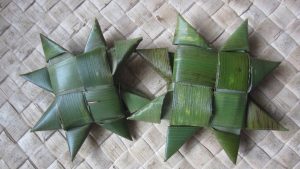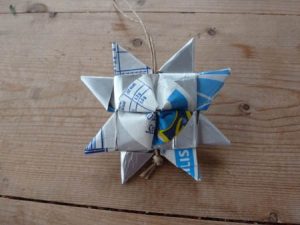Category: Woven stars
Star weaving, Fröbelstern, Flax star, harakeke whetū, Stjerneflet, Advent star, Danish star, German star, Nordic star, Pennsylvanian star, Polish star, Swedish star, Christmas star, Julestjerne, Poinsettia
The 2D or flat star has 8 points and is made from 2 or 4 strips of paper, card, fabric etc. The 3D star has a further eight cone-shaped tips. According to Wikipedia the weaving and folding procedure can be accomplished in about forty steps. The star can be considered a form of origami, because it is made of identical paper sheets and assembled without glue. However, as it combines folding with weaving it is more a “fringe” subject of origami.
Although knowledge of how to make the stars was thought to already be widespread in countries such as Germany, the Froebel star got its name from German educationist Friedrich Fröbel (1782–1852), who taught paper folding as a way of introducing simple maths in Kindergartens.
Froebel stars are still common in Germany and used as an ornament on Christmas trees and wreaths, and to make garlands and mobiles. Traditionally the stars would be dipped into wax and sprinkled with glitter after being folded.
They also feature in Maori culture in the New Year celebration of Matariki when the constellation Pleiades appears.





